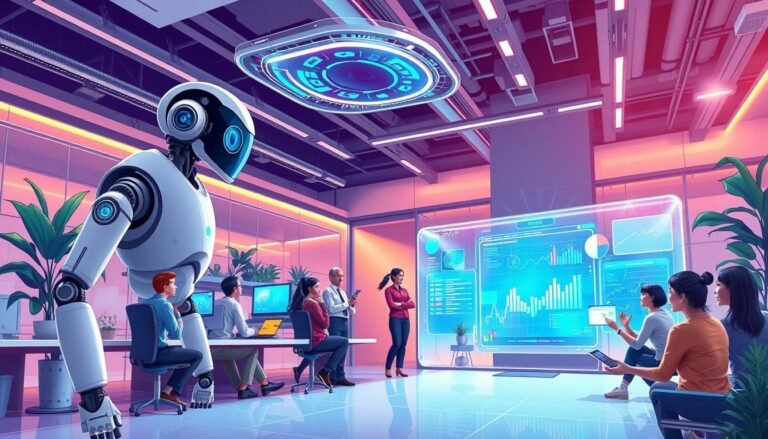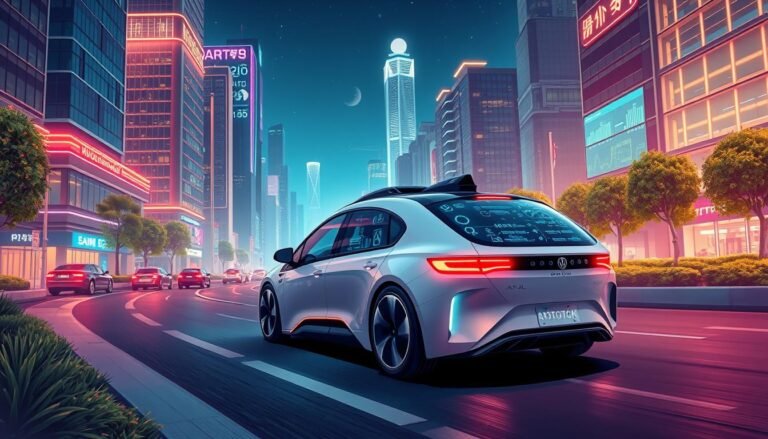AI in Drone Technology: Revolutionizing Flight
Ever wondered how drones can fly through complex spaces like humans? It’s thanks to AI in drone tech. This new mix is changing how drones work, opening doors in many fields.
Autonomous flight control is now a reality, not just a dream. Drones with AI can make quick decisions, adjusting to new situations instantly. This change isn’t just about cool tech; it’s changing how we do tasks from farming to rescue missions.
Drone data analytics, powered by AI, is also a big deal. These drones don’t just gather data; they analyze it right away. This makes them airborne problem-solvers, giving us insights we couldn’t get before.
As we explore this exciting field, we’ll see how AI is changing the sky. From flying in groups to precise mapping, the future of flight is here.
Key Takeaways
- AI enables drones to navigate autonomously in complex environments
- Autonomous flight control enhances drone capabilities across various industries
- Real-time data analytics powered by AI transforms drones into airborne problem-solvers
- AI in drone technology is revolutionizing tasks from agriculture to search and rescue
- The integration of AI and drones is opening up new possibilities in aerial operations
The Evolution of Drone Technology
Drone technology has grown a lot since it started. It moved from military use to helping civilians. Now, drones use AI and machine learning for new tasks.
From Military to Civilian Applications
At first, drones were for the military. But now, they help people in many ways. The U.S. Navy shows drones are still key in defense.
A big $6.7 billion contract for more ships shows the Navy’s commitment. They will get eight more John Lewis-class vessels.
| Aspect | Details |
|---|---|
| Contract Value | $6.7 billion |
| Number of Ships | Up to 8 additional |
| Ship Capacity | 162,000 barrels of oil |
| Maximum Speed | 20 knots |
The Rise of AI-Powered Drones
AI has changed drone use, like in archaeology. In 2019, AI helped find 143 new geoglyphs in the Nazca Lines. This shows AI and drones can do amazing things together.
Key Milestones in Drone Development
Drone tech has improved a lot. Now, drones can fly longer, navigate on their own, and sense their surroundings better. These changes help drones do tasks like mapping and farming.
- Enhanced battery life for longer flight times
- AI-powered autonomous navigation
- High-resolution sensors for data collection
- Machine learning algorithms for data analysis
Drone tech will keep getting better. We’ll see even more amazing uses for drones in the future.
Understanding AI in Drone Technology
AI has changed how drones work. It uses computer vision and deep learning to make drones smarter. Now, drones can move through tough spots, dodge things, and do complex tasks on their own.
Computer vision lets drones see and understand what’s around them. It uses cameras and sensors to get visual info. Then, deep learning makes sense of this data. This way, drones can spot things, follow them, and decide fast.
AI has made drones much better in many areas. For example, in disasters, AI drones can quickly see damage, find people, and help rescue teams. In farming, they check on crops, find pests, and help water plants just right.
“AI-powered drones are not just flying cameras; they’re intelligent machines capable of making complex decisions in real-time.”
Here’s a quick look at the main AI parts in drones today:
| AI Component | Function | Application |
|---|---|---|
| Computer Vision | Visual data processing | Object detection, mapping |
| Deep Learning | Data analysis and decision-making | Autonomous navigation, obstacle avoidance |
| Machine Learning | Pattern recognition and prediction | Flight optimization, anomaly detection |
As AI gets better, drones will do even more amazing things. We’ll see drones working together and using data in new ways. The future of AI drones is exciting and full of possibilities.
Machine Learning Algorithms for Autonomous Flight
Machine learning is changing drone technology. It makes drones fly on their own and navigate better. These algorithms are key for drones to work without much human help.
Supervised Learning in Drone Navigation
Supervised learning is big in drone navigation. Drones learn from labeled data to understand their surroundings. This helps them plan paths and avoid obstacles in known areas.
Unsupervised Learning for Anomaly Detection
Unsupervised learning finds patterns and oddities in drone data. It’s great for spotting issues during flight. Drones can catch problems early by looking at lots of sensor data.
Reinforcement Learning in Dynamic Environments
Reinforcement learning is a big deal for drone navigation. It lets drones adjust to changing situations by learning from their actions. Recent progress has shown great results:
- The X-62A VISTA, based on an F-16D Block 30 aircraft, successfully completed 12 AI-piloted flights in December 2022.
- DARPA awarded a $4 million contract to develop AI and ML systems for autonomous Beyond Visual Range combat.
- Turkey is pushing the development of AI-enabled UCAVs for advanced aerial combat scenarios.
These achievements show how far reinforcement learning has come. It’s making drones better at flying and even at combat. As these algorithms get better, we’ll see drones do even more amazing things.
Computer Vision and Object Detection in UAVs
Computer vision is changing how drones see and move around. It lets drones spot objects, see patterns, and move through tricky places with great accuracy.
Deep learning is key in making drones understand what they see fast. These smart algorithms help drones make quick choices based on what’s around them. This boosts their freedom and what they can do.
- Detecting flowering nectar source trees in mixed forests using high-resolution sensors
- Identifying blooming areas through the Enhanced Blooming Index (EBI)
- Counting maize seedlings with YOLOv8n, achieving an F1 score of up to 94%
- Recognizing and counting cars with over 90% accuracy using YOLOv5
The LRI-YOLO model is a big step forward for UAVs. It makes drones better at finding objects by using less power and getting more accurate, especially with small and infrared objects.
| Model | Application | Accuracy |
|---|---|---|
| YOLOv8n | Maize seedling counting | Up to 94% F1 score |
| YOLOv5 | Car detection and counting | Over 90% |
| LRI-YOLO | Small and infrared object detection | Enhanced accuracy |
As research keeps going, computer vision for UAVs will get even better. This will open up new areas in precision farming, city planning, and watching the environment.
AI-Powered Drone Mapping and Surveying
AI-powered drone mapping is changing industries with its advanced features. Drones with AI can make very accurate 3D models of landscapes. This changes how we see and interact with our surroundings.
3D Terrain Modeling
Drones with AI can make detailed 3D models of landscapes. These models help many sectors, like mining and construction. For example, in mining, drones can monitor areas with high precision.
Precision Agriculture Applications
AI drones are changing farming. They can spot plant diseases, check crop health, and improve water use. New tech has made spotting pests and diseases faster and more accurate.
Urban Planning and Infrastructure Inspection
Drones with AI are key for city planning and checking buildings. They can quickly and safely survey big areas, finding problems early. In checking for subsidence, drones use LiDAR to get precise 3D data.
Drone data analytics are key to understanding the data drones collect. The Model-to-Cloud Comparison Algorithm (M3C2) shows how surfaces change with high accuracy. This helps city planners and engineers make better decisions about building and upkeep.
Intelligent Drone Swarms: Coordinated Flight
Intelligent drone swarms are changing how we fly drones together. They use AI to make drones work as a team. The UK is leading this effort, planning to use up to 30 drones for firefighting.
These drones are big and can carry a lot of water. They have a 9.5-meter wingspan. The next step is to make them work together better in real life.
This tech is inspired by how birds and insects fly together. It’s being used for many things, like fighting wildfires and protecting the environment. AI drones are helping tackle big climate problems.
“The potential of intelligent drone swarms in environmental protection is expanding as drone technology evolves and matures.”
In the defense world, Anduril is making big steps in drone control. They’ve had over 200 real flights and 40,000 simulations. Their Lattice software is improving how drones work together.
The University of Leeds is testing how drone swarms can collect data in cities. This method is better because it’s scalable, adapts quickly, and is cheaper than old ways.
- Traffic monitoring and management
- Disaster response and emergency management
- Environmental monitoring
As drone swarms get smarter, they will change many areas. They will help with city planning and disaster response. We’re entering a new era of flying together.
Neural Networks for Obstacle Avoidance
Drones are getting smarter thanks to neural networks for obstacle avoidance. These AI systems help drones fly safely in tricky spots. Let’s look at how this tech works and why it’s so important for drone flight.
Real-time Path Planning
Neural networks help drones plan their routes on the fly. They process data from cameras and sensors to spot obstacles. This lets drones adjust their path in real-time, avoiding crashes. It’s like giving drones their own set of eyes and a quick-thinking brain.
Sensor Fusion Techniques
Drones use many sensors to “see” the world around them. Sensor fusion combines all this data to create a clear picture. Neural networks crunch this info, helping drones understand their surroundings better. This tech makes drones safer and more reliable in complex environments.
Edge Computing for Faster Response
Speed is key when dodging obstacles. Edge computing brings processing power right to the drone. This means faster thinking and quicker reactions. It’s a game-changer for drone safety, especially in busy or unpredictable places.
Machine learning for drones is advancing fast. These smart systems are making drones more capable and safer to use. As the tech improves, we’ll see drones taking on more complex tasks in our skies.
| Feature | Benefit |
|---|---|
| Real-time Path Planning | Instant route adjustments |
| Sensor Fusion | Better environmental awareness |
| Edge Computing | Faster obstacle avoidance |
Deep Learning in Drone Data Analytics
Deep learning is changing how we use drone data analytics. It makes it easier to understand the huge amounts of data drones collect. This technology is now used in environmental monitoring, checking infrastructure, and in precision farming.
Drones can now spot and track specific items very accurately thanks to deep learning. This is really helpful in search and rescue, protecting wildlife, and planning cities. AI in drone data analytics can find patterns and oddities that people might miss.
The U.S. military is looking into using AI for aerial battles. DARPA gave a $4 million contract to BAE Systems’ FAST Labs to work on AI for autonomous combat. In tests, AI-controlled an X-62A aircraft 12 times in simulated battles, showing AI’s role in future air fights.
As drone tech gets better, we’ll see more cool uses of deep learning in data analysis. From better crops to stronger military, drones and AI are creating new chances in many fields.
Source Links
- Advanced Network Enables US Army to Operate in a Dispersed Manner
- Russia’s New Long-Range Drone: The Garpiya-A1
- US Navy: General Dynamics gets contract for John Lewis-class fleet
- 35 Facts About Nazca Lines
- Cascading Landslide: Kinematic and Finite Element Method Analysis through Remote Sensing Techniques
- Deformation-Adapted Spatial Domain Filtering Algorithm for UAV Mining Subsidence Monitoring
- Ukraine deploys demining drones in battle for the Dnipro
- DARPA Awards BAE Systems $4 Million for Autonomous Beyond Visual Range Air Combat Program
- Dynamic Target Tracking and Following with UAVs Using Multi-Target Information: Leveraging YOLOv8 and MOT Algorithms
- Robots for the Energy Transition: A Review
- Detection and Assessment of White Flowering Nectar Source Trees and Location of Bee Colonies in Rural and Suburban Environments Using Deep Learning
- A Lightweight Real-Time Infrared Object Detection Model Based on YOLOv8 for Unmanned Aerial Vehicles
- Object Detection in Remote Sensing Images of Pine Wilt Disease Based on Adversarial Attacks and Defenses
- AI-Piloted Drones Could Help Prevent Wildfires
- Sneak Peek: Anduril Lifts Veil on Its Combat Drone Software
- Advancing Smart Cities with Multi-Drone Swarm Intelligence
- Empowering UAV Communications with AI-Assisted Software-Defined Networks: A Review on Performance, Security, and Efficiency – Journal of Network and Systems Management
- Reinforcement learning-based drone simulators: survey, practice, and challenge – Artificial Intelligence Review







